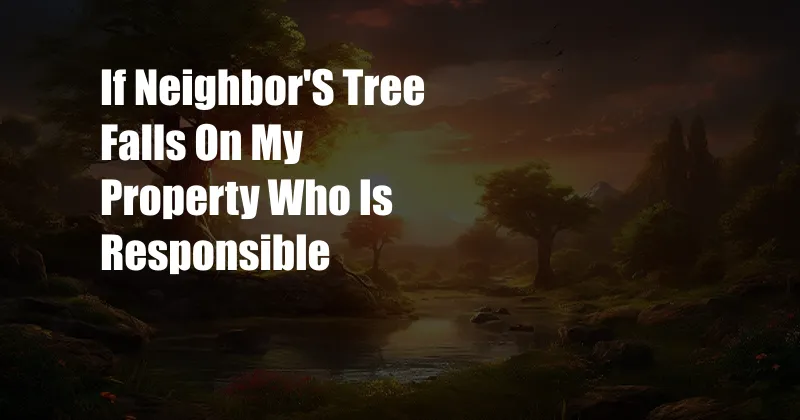
Neighbor’s Tree Falls on My Property: Who’s Responsible?
Imagine the shock and distress of waking up to the devastating sight of your neighbor’s towering tree sprawled across your property. The colossal branches have crushed your fence, damaged your shed, and even breached your home’s roof. In the aftermath of this arboreal catastrophe, amidst the chaos and confusion, an important question lingers: who bears the responsibility for the destruction?
Determining liability in such cases involves a complex interplay of legal doctrines and property laws. This article delves into the intricacies of this issue, providing a comprehensive guide to understanding the legal implications and navigating the aftermath of a fallen neighbor’s tree.
Legal Framework for Tree Liability
The legal framework governing tree liability varies from state to state, but certain general principles apply. In most jurisdictions, the concept of “premises liability” governs such cases. Premises liability holds property owners responsible for injuries or damages occurring on their property due to negligence or hazardous conditions.
When a neighbor’s tree falls on your property, the legal analysis focuses on whether the tree’s owner breached their duty of care. This duty requires property owners to take reasonable steps to prevent harm to others, including maintaining their trees in a reasonably safe condition.
Proving Negligence
To establish negligence in a fallen tree case, the injured party (the plaintiff) must demonstrate that:
- The tree owner owed them a duty of care
- The tree owner breached their duty by failing to take reasonable care
- The breach of duty directly caused the damage
The plaintiff’s burden of proof is less demanding if the tree was in a “defective” condition, such as having a diseased or weakened root system, and the tree owner knew or should have known about the defect. In such cases, the doctrine of “negligence per se” may apply, presuming that the tree owner was negligent.
Exceptions to Liability
Certain exceptions to premises liability may shield tree owners from liability in some cases, including:
- Natural Disasters: If the tree fell due to an act of nature, such as a storm or tornado, the tree owner may not be held liable.
- Trespassing: If the plaintiff was trespassing on the tree owner’s property when the tree fell, they may not have legal standing to sue.
- Assumed Risk: If the plaintiff was aware of the tree’s hazardous condition and voluntarily assumed the risk of harm, they may not be able to recover damages.
Insurance and Resolution
Most homeowners’ insurance policies include coverage for tree damage. If a neighbor’s tree falls on your property, contact your insurance company promptly to file a claim. Your insurance company may then pursue the neighbor’s insurance company for reimbursement.
In some cases, tree fall disputes can be resolved amicably through negotiation or mediation. Both parties may benefit from working together to find a solution that minimizes legal costs and preserves neighborly relations.
Tips and Expert Advice for Handling Tree Fall Disputes
- Document the Damage: Take photographs and videos of the damage and the fallen tree.
- Contact Neighbors: Inform your neighbor about the damage and the need for repairs.
- File an Insurance Claim: Contact your insurance company to report the incident and initiate a claim.
- Hire an Arborist: If the cause of the tree fall is unclear, consider consulting an arborist to assess the tree’s condition.
- Seek Legal Advice: If negotiations with your neighbor or insurance companies fail, consider consulting an attorney.
Explanation: By promptly documenting the damage, communicating with neighbors, and initiating an insurance claim, you can establish a clear record of events and protect your legal interests. Hiring an arborist can provide expert insights into the cause of the tree fall, while legal counsel can guide you through the legal process.
FAQ on Tree Fall Liability
-
Q: Who is responsible if a tree owned by the city falls on my property?
A: In such cases, the city may be deemed the “property owner” and held responsible for damages under principles of premises liability. -
Q: What if I contributed to the tree’s fall by not trimming branches overhanging my property?
A: Comparative fault principles may apply, potentially reducing your compensation if you were partially at fault. -
Q: Can I sue my neighbor for emotional distress caused by a fallen tree?
A: In some cases, you may be able to recover damages for emotional distress if you can prove that the neighbor’s negligence caused your suffering.
Conclusion
Determining liability for a fallen neighbor’s tree involves complex legal considerations. By understanding the principles of negligence, exceptions to liability, and insurance coverage, you can navigate the aftermath of such an event with greater confidence. Remember, taking prompt action, seeking expert advice, and pursuing amicable resolutions can help mitigate legal costs and preserve neighborly relations.
Are you interested in learning more about the legal implications of fallen trees? Share your questions or insights in the comments section below.